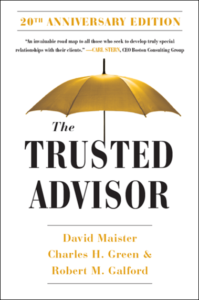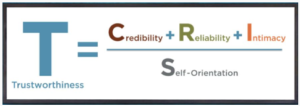20 Years of Trust: What Has Changed
It’s been 20 years since the release of The Trusted Advisor. As we began the process of creating the 20th Anniversary Edition, we dived into deep reflection on how building trust has changed over the last two decades.

Surely it had to be vast… when the first book was released many people didn’t have an email address. Business was done face-to-face, and Zoom’s inception was 10 years away. But as we analyzed further, the initial presumption that so much would need to be changed for the new book to be relevant shifted.
Technology and digitization have brought the biggest transformations over the past two decades, causing ripples that affect all aspects of our lives, both personal and professional. And yet, the models for building trust that we laid out 20 years ago have remained steadfast, and many have actually become more important in creating meaningful relationships. The fundamentals of trust-building – that is, what creates trust – haven’t changed. It’s how we do them that has evolved.
Trust is (and always will be) the result of an interaction between a trustor and a trustee. When one person takes the risk to trust another, who in return is trustworthy, the end result is trust.
The Trust Equation is the trust model that has been impacted most in the last 20 years. It is also still the best guide to create impactful relationships built on trust.

Here’s what we’ve seen changed within the Trust Equation:
Credibility
Twenty years ago, credibility could only be established through interpersonal interaction. In business, that meant investing a large amount of time – in-person meetings, lunches, numerous phone calls – was the only way to verify someone’s credibility. And it took a lot of time. But time spent does NOT equal trustworthiness.
Credibility can now be ascertained largely online. We can determine if we want to take the first step to trust by looking at a website, checking a LinkedIn profile or filtering online reviews. We have intel before the introduction is even officially made, which can be a double-edge sword; it can move the process along more quickly to the emotional aspect of credibility (if the person accepts the digital info as positive) OR it can discredit immediately (if the person accepts the digital info as negative).
Reliability
Reliability is about dependability – delivering on one’s promises – and predictability. Technology can be a conduit to reliability, but people trust people, not algorithms. True reliability takes multiple interpersonal interactions to give the other person a sense of what to expect. If used correctly, technology can be a great aid in achieving reliability by providing more channels to show up authentically. Unfortunately, in the last 20 years it’s been more of an impediment than an amplifier when people rely solely on tech and avoid the human aspect.
Intimacy
Intimacy is the biggest builder of trust and is purely interpersonal. Because the time-frame of trust building has been shortened by the internet (as the world is altogether moving at a faster pace), it’s more essential than ever to get this piece right. If face-to-face interaction has decreased 80%, the remaining 20% must be qualitatively sharper (especially since it’s probably virtual today). Even though we can now come to the table with commonality and connection due to online research, true intimacy only happens between two people who meet each other half way. The fact that the overall time available to build intimacy has decreased means the time spent building intimacy holds even more weight.
Self-Orientation
The biggest impact in self-orientation isn’t a change to self-consciousness (“Am I smart enough? Did I say the right thing? Do I belong here?”) but to focus. Constant technology distractions have shortened our attention spans, and it’s more difficult to give someone the necessary attention to build trust, especially virtually, when you can hide the fact that you’re checking devices when you’re supposed to be engaged. Even in-person interactions have flailed. Try to think of the last time you had a meeting with two or more people where at least one of them didn’t check their smartphone. It’s an anomaly these days.
In Summary
Although some elements of trust have changed in the last 20 years, the Trust Equation as a model to build trust has remained solid and is more relevant than ever. When we think about the digital world, we might assume that more information and improved processes would make it easier for us to connect meaningfully, but that hasn’t happened. When vital aspects of trust building are lost or overlooked due to the convenience of technology, trust will falter.
Give trust building the time and energy it deserves, and use technology not to replace important interpersonal interaction, but to amplify it.

Trackbacks & Pingbacks
[…] aquí 20 Years of Trust: What Has Changed para ver el documento […]
Leave a Reply
Want to join the discussion?Feel free to contribute!